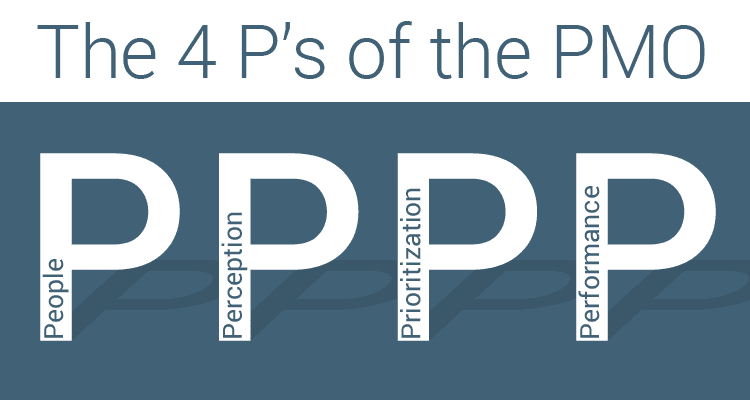
Almost everyone has heard of the four P’s of marketing – product, pricing, promotion, and place. Marketers use these to help develop a marketing and go-to-market strategy for their product or services. The marketing four P’s serve as a guideline. A PMO should also have four P’s that can provide a guideline for PMO teams and processes. By looking at people, prioritization, perception, and performance, you can find ways to improve your PMO’s value contribution.
People
In a recent survey, it was reported that over 70% of organizations do not have enough resources to meet incoming project demand. On the surface, this does not sound surprising – who has resources sitting around, twiddling their thumbs and waiting for work? No one. This poses one of the most important questions a member of the PMO can ask, “Are our people working on the right things?” Although the people in your organization might be busy, you must ensure they are focused on the most valuable work that is being requested by the organization, as this will create the greatest business impact.
In addition to most organizations not having enough resources, 46% also reported that resourcing is their #1 challenge – even more challenging than prioritization, alignment, or benefits realization. Bottom line is that no one has more resources than they need. Proper resource optimization will become more important over the next 12-18 months as there is concern over the upcoming election, volatile public markets, failing unicorns, and venture capital investments drying up. The uncertainty is causing organizations to re-think their hiring strategy and create urgency to get more done with existing resources.
An optimized and on-track PMO should be able to report what their people are working on (at the role, skill, and individual level) and be able to tie those allocations to initiatives or goals that the organization has categorized as a priority. People get things done and you want to ensure they are deployed on the right projects and work.
Perception
It should be no surprise that PMO value is consistently questioned. Why shouldn’t it be? PMOs are cost-centers that do not generate any revenue, right? Wrong. PMOs are value-centers and it is important for PMO leaders and team members alike to constantly communicate and demonstrate their value.
Whether you are part of an enterprise PMO (ePMO) focused on compliance and governance across the entire organization or a full service PMO that is focused on completion of innovation projects to enable a line of business (LoB), your goal remains the same – deliver results to propel the business forward, which is VERY valuable.
Gartner, at their annual PPM and Governance Summit, stated that 48% of organizations say their PMO is an “integral part for getting things done.” This is both positive and negative. On one side, the PMO is valued for its execution capabilities, but the downside is that there is no mention of adding value or moving the business forward. This is a perception challenge, not a functional or operational problem. Furthermore, 31% of the respondents said the PMO provides “a useful administrative function” and only 19% of organizations say their PMO “adds value but is bureaucratic.” Most would agree that these results are subpar and represent perceptions, not reality. While the general perception is PMOs can execute, there is a tremendous opportunity to demonstrate the value contribution of the PMO.
PMOs need to increase their business mindset by thinking, communicating, and managing to value or business outcomes, not just execution. Part of the issue is how PMOs are goaled. In a recent survey, 50% reported their PMO’s primary goal is on-time and on-budget project delivery. If PMOs want their perception to change, then the behavior, emphasis, and goals need to change as well. A simple way this can be achieved is through proper alignment and prioritization of work – which brings us to the third “p.”
Prioritization
The challenge with prioritization is the business environment is constantly changing as competitive, market, and internal forces create moving targets for your PMO. What was urgent and important yesterday may not be today, creating an environment where it is difficult to prioritize work. This results in the PMO simply focusing on executing what is in front of them.
Through proper prioritization and scoring of projects or initiatives, a PMO can have data-driven discussions with stakeholders to answer the question “what is the real value or benefit of this work and how important is it relative to other projects?” By taking this data-driven approach, your PMO has the opportunity to improve prioritization processes. Your ability to have informed discussions is directly related to your PMO’s perception (the importance of which we discussed above). The key to becoming more integral in your organization correlates with your ability to tie efforts to delivered value, not just project delivery. This means utilizing proper scoring and prioritization processes with stakeholders, introducing agility to account for change, and constantly striving towards alignment with business goals and objectives.
Performance
The natural transition from prioritization is measuring PMO performance. According to data presented at the latest Gartner PPM Summit, there is a disconnect between what the PMO is measuring and the actual level of effectiveness of those metrics. Effectiveness, in this case, was rated by business stakeholders who received the outputs of PMO activities. The short of it is simple, PMOs need to measure performance in the form of outcomes, not activities. For example, we discussed above that over 50% of PMO organizations are goaled towards on-time or on-budget projects. It should be no surprise that, “completion within budget” and “on-time completion,” are the two most popular metrics measured by PMOs, as reported by Gartner. However, when organizations were asked about these metrics’ corresponding level of effectiveness, they were at the bottom of the list. While these metrics measure the output of the PMO organization, these metrics are not effective in measuring the value of the PMO’s activities on the business.
At the top of the effectiveness list were the following two measures: “results directly supporting a major business strategy goal” (i.e. alignment) and “full delivery of the value captured in the original business case” (i.e. business outcome). However, these measures were at the bottom of the list when it comes to the actual metrics used among PMO organizations. In fact, with both metrics, less than 44% of PMOs are reported as using these performance measures. There is a fundamental gap in how PMOs measure their performance and how the business stakeholders view the PMO’s performance.
PMOs must start by having the conversation with their business stakeholders. Getting a clear understanding of the expectations of the PMO and then agreement on what metrics both organizations will measure is critical in having a high performing PMO. While this may be challenging and time consuming up front, ironing out these details will help with the perception, value contribution, and overall reputation of your PMO.
While the four P’s of the PMO may seem like common sense or too basic, the data reveals that most organizations do not have everything in place – demonstrating an opportunity for improvement regardless of PMO maturity. Running a PMO is challenging and sometimes breaking down the charter into the four P’s can help drive the organization toward some common goals.
What are your thoughts on the four P’s?




